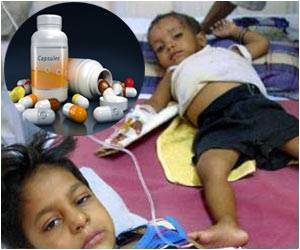Humans are passing antibiotic resistance to wildlife, especially in protected areas where numbers of humans are limited, discovers a team of Virginia Tech researchers.

The study also reveals that humans and mongoose appear to be readily exchanging fecal microorganisms, increasing the potential for disease transmission.
"The research identifies the coupled nature of humans, animals, and the natural environment across landscapes, even those designated as protected," said Kathleen Alexander, an associate professor of wildlife in Virginia Tech's College of Natural Resources and Environment. "With few new antibiotics on the horizon, wide-scale antibiotic resistance in wildlife across the environment presents a critical threat to human and animal health. As humans and animals exchange microorganisms, the threat of emerging disease also increases."
The National Science Foundation-funded research project investigating how pathogens might move between humans and animals was published today (April 24, 2013) by EcoHealth.
"Tracking Pathogen Transmission at the Human-Wildlife Interface: Banded Mongoose and Escherichia coli" is co-authored by Risa Pesapane of Portsmouth, Va., then a wildlife sciences master's student at Virginia Tech; microbiologist Monica Ponder, an assistant professor of food science and technology in Virginia Tech's College of Agriculture and Life Sciences; and Alexander, who is the corresponding author.
Alexander and Ponder are both affiliated with Virginia Tech's Fralin Life Science Institute.
Advertisement
The researchers collected fecal samples from three troops of banded mongoose living in Botswana's Chobe National Park and three troops living in villages outside the park.
Advertisement
With the exception of one mongoose troop, all study animals had some level of their range overlap with human populations. Two of the study troops had home ranges that included ecotourism facilities in the protected area, with some contact with humans and development "but at a much lower level than in the village troops," the article reported.
Fecal samples were collected from these mongoose troops living in a protected area and in surrounding villages. Human feces were collected from sewage treatment facilities, environmental spills, and bush latrines or sites of open-air defecation within mongoose home ranges.
The team used Escherichia coli (E. coli), which is commonly found in the gut of humans and animals, as a model microorganism to investigate the potential for microorganisms to move between humans and wildlife. They evaluated the degree of antibiotic resistance considered an important signature of bacteria that arise from human sources.
The researchers also extracted data from the local hospital to assess antibiotic resistance among patients and identify resistance patterns in the region. Like many places in Africa, antibiotics are widely available and there are few controls on the dispensing of such drugs.
The project screened for nine locally available antimicrobials, including ampicillin, tetracycline, doxycycline, and streptomycin, as well as ceftiofur, a veterinary drug not available in the study area.
The researchers discovered 57 percent of banded mongoose had E. coli that was antibiotic resistant. "Resistance was identified among individuals in all sampled troops," the article reports.
The animals were most commonly resistant to ampicillin, followed by doxycyline, tetracycline, and streptomycin. But it was the prevalence of multidrug resistance that was most alarming.
"There was a significant difference between troops in protected area and those outside the park, although not what you might expect," said Alexander.
One troop in the town of Kazungula, outside the protected area, had the lowest level of multidrug resistance among sampled mongoose, while a troop from the protected area living near an ecotourism facility had the highest levels.
At least one sampled mongoose in this particular troop in the protected area was resistant to each of the 10 antibiotics screened in the study.
As is common of mongoose that live near humans, the troop near the ecotourism facility utilized the opportunities presented by its human neighbors, setting up residence in the drain fields of the open septic tanks servicing the employee accommodations and foraging around employee living quarters, including eating food remains from dishes left outside. One interaction between the employees resulted in an unexpected finding — the kitchen staff fed raw meat waste from commercially produced chickens to mongoose.
"This may be how the mongoose developed resistance to ceftiofur," said Alexander.The one troop living in an undisturbed region of the park was resistant to only ampicillin. "These findings reinforce the significance of human impacts to natural environments, even when human numbers are low," said Alexander.
The article reports that mongoose were resistant to the same antibiotics as humans in the region, but at a lower level. Of human fecal samples collected in the mongoose home ranges, 80.3 percent were resistant to at least one antibiotic. Of the human clinical samples screened at the local hospital, 89.9 percent of various isolated bacteria species were resistant to at least one antibiotic.
"This work identifies direct support for the possibility that direct human fecal contamination of the environment is an important potential source of microbial exposure and transmission to wildlife living in these areas," said Ponder, who was with the U.S. Centers for Disease Control and Prevention before coming to Virginia Tech."Ecotourism developments are important for conservation and economic growth, but the associated human waste, which includes garbage as well as feces and waste water, may expose wildlife to human-associated pathogens and antibiotic resistance, ultimately increasing future threats to human health," said Alexander.
The project was funded by a National Science Foundation (NSF) Dynamics of Coupled Natural and Human Systems award, the Morris Animal Foundation, and the WildiZe Foundation. The NSF Scholarships in Science, Technology, Engineering, and Mathematics program also provided partial financial support for Pesapane.
"The impact of microbial exchange and antibiotic resistance accumulation in mongoose may extend through food webs," the researchers conclude. "Mongoose are eaten by a large number of avian, reptile, and mammalian predators including domestic dogs. Thus, the cascading effects of exposure of wildlife species to human waste-associated microbes can impact an array of susceptible species across an ecosystem and in turn increase human exposure, coupling humans and natural systems in complicated ways."
They recommend closed sewage systems, wildlife-proofed trash receptacles, and prohibiting feeding poultry and livestock products from kitchen waste to either wildlife or domestic animals.
"As we change our natural environments, these modifications can in turn impact our own health," said Alexander. "We are working with the Botswana Ministry of Health and Ministry of Environment, Wildlife, and Tourism to minimize these impacts and develop sustainable approaches to the protection of human, wildlife, and ecosystem health."
Pesapane said the research experience reinforced that "the issue of global sustainability and health is multifaceted, and an interdisciplinary approach is vital to achieving progress in managing health threats at this complex interface."
Pointing out the interconnectedness of human health and wellbeing and conservation of natural resources, she said, "We cannot begin to address issues of conservation without also improving quality of life in neighboring communities.
"The Virginia Tech/CARACAL program under the NSF-funded program embodied this concept with expanded program focus beyond research in the Chobe region to include educational outreach and partnered efforts with the Government of Botswana to improve the quality of life for the citizens of Botswana," she added.
Pesapane, who completed her master's in wildlife science at Virginia Tech in December 2011, is now project director of Rural System Inc. "My experience with the Alexander lab, its nonprofit affiliate CARACAL, and my education in the fish and wildlife conservation department at Virginia Tech provided a solid foundation for an inspiring career in global conservation," she said.
"Our next step," Alexander said, "is to begin to unravel the interdependent natural and human drivers of microorganism exchange, emergence of disease, and spread of antibiotic resistance among wildlife and across environments. This will be essential to our ability to effectively manage this interface and protect the health of humans, wildlife, and environments on which we depend."
Source-Eurekalert












